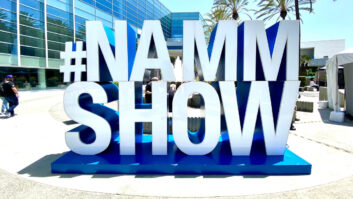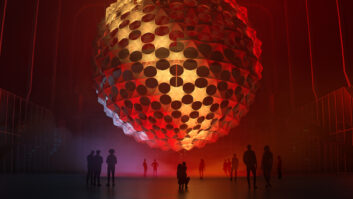
Now in its second season, the hip weekly PBS series Sessions at West54th has become television’s most reliable source for high-quality liveperformances by an eclectic array of artists from the pop, blues,country and jazz worlds. Most of the one-hour Sessions programs presenttwo acts for about 25 minutes each, and fill the remaining time withinterviews conducted by the show’s host, ex-Talking Heads frontmanDavid Byrne, himself a guest during the first season.
Much of the show’s appeal comes from the feeling of intimacy in theperformances-at its best, the show seems like a private concert forfriends. It’s taped in Manhattan before a live audience of around 200on Stage A of Sony Music Studios’ cavernous West 54th Street facility(which was once a Fox movie soundstage). The visuals (it’s a six-camerashoot) and sound are both top-notch, and that’s a major reason whySessions has been able to draw such a wide range of musicians,including Ben Folds Five, Beck, Richard Thompson, Elvis Costello andBurt Bacharach, Liz Phair, Cowboy Junkies, Lyle Lovett, the Pat MethenyGroup, Lou Reed, Taj Mahal, Lucinda Williams, the Afro Cuban All-Stars,Jimmy Scott and many others.
“The idea of the Sessions sound is for the audience to hear what theacts hear onstage,” says the show’s recording/mixing engineer, TomCadley. This means bringing the audience right onto the soundstage,figuratively speaking. This is accomplished, in part, by using one ofrecording’s oldest and simplest microphone arrangements: the three-micoverhead configuration commonly known as the Decca Tree (coined byclassical engineers for Decca Records many years ago). Cadley says theDecca Tree defines the sound of the show: “You’re definitely hearingthe room; you hear what the musicians hear onstage, not my idea of whatit should sound like using this or that reverb unit.”
With such a wide variety of musical styles, the role of the DeccaTree is subject to a lot of variation. “For an acoustic act like theDel McCoury bluegrass group, I’ll lower the Decca Tree so that I canfocus the mics and get a direct pickup with a clear image,” Cadleysays. “That works because the act is five guys around a mic who walk upto do their solos. For someone like Liz Phair, with a loud rock band,the Decca Tree will be up near the lighting grid, and it will be mixedin essentially as a drum reverb.” Cadley says his left-center-rightDecca setup is most often fitted with three Neumann TLM 170omnidirectional mics.
To work successfully with the wide range of acts that appear onSessions, Cadley must be familiar with all types of music. “You have toknow things like how important the clave is to a group like the AfroCuban All-Stars,” he explains. “It’s easy to lose a clave with all thehorns and percussion going on. Fortunately I never wanted to be aspecialist, and my experience doing jingles, where you would cut a Cokespot for Latin, easy listening and rock stations all on the same day,turned out to be wonderful training.” Cadley began his career as BobClearmountain’s assistant at Bearsville Studios in upstate New York andhas since engineered rock records for Joan Jett, Charlie Sexton,Midnight Oil and others.
Cadley records the show on a Sony 3348 48-track digital machine andmixes to a Sony PCM800 in Sony Music Studios Mix A, through a 96-inputSSL analog board. (The audience tracks and host are tracked on thePCM800.) He uses Genelec and Meyer near-field speakers, leaving theroom’s giant built-in Boxer monitors alone. To get an idea of what theshow sounds like on a single-speaker television, Cadley uses thebuilt-in speaker on a Studer 2-track recorder, set across the room fromthe mix position like a TV would be in a living room. “That’s how I cantell if the bass is sitting right,” he says. “If it’s too loud, itblows out the speaker, and if it is too low you can’t hear it at all. Ilearned this from Bob Clearmountain; some people at Media Soundapparently discovered how much that little speaker in the Studerssounds like a TV.”
So who does Cadley mix for-the person who casually flicks on the setor those who run the sound through their stereo system? “I mix for theperson listening through their stereo, and I do it quite dynamically. Alot of people who mix music for television use a lot of compression sothat everything’s really loud. I don’t care for that approach. It’squite easy for a person to turn up their sound level on the TV during asoft passage.” (Sessions is currently mixed only for stereo.)
Cadley keeps the outboard gear minimal. “I use a Summit AudioDCL-200 dual compressor-limiter for most everything I do,” he says.”It’s warm and you can adjust the attack and release. For reverb I plugin a ton of gear,” he adds, pointing to the array of equipment sittingbehind him. “Then I’ll ultimately use only two or three things, mostlya couple of small room programs from the board’s Lexicon 480L. I’lloften use an AMS RMX reverb unit for those canyon-like echoes on longsax solos.”
Cadley is usually involved in all aspects of the production,including the microphone choices. He eschews piano transducers becauseof problems with hot spots and left hand definition. And as the lidsare normally closed for camera purposes, he has devised his ownsolution-a pair of Schoeps MK4s (with Avalon preamps) attached underthe lid, padded with foam, with the head angled down. “The Schoeps areset right above the piano’s big iron support beams. People look at itand say, ‘Well, you’ll get the sound of the beams really nicely,’ butthe coverage is smooth and even, and it has some sense of space, whichis what I’m after.”
The drums get Coles 4038 ribbon mics set high above the kit. “That’smy drum sound; I use 57s and 58s or Audix D3s for the snare and toms. Ilike the Audix mics because they’re small and camera-friendly. The kickgets an M88. But those additional drum mics are mostly for addeddefinition; the overhead Coles are what I use most. They’ve got a bigdiaphragm and a nice top-end roll-off that keeps the cymbals from goingsizzly and loud,” Cadley says. The bass is usually taken direct, thoughCadley sometimes adds a mic to get the cabinet sound as well.
Choice of vocal mic turns out to be an area the musicians usuallyhave an opinion about. “Acts come in here during their tours andthey’re used to using Shure SM57s and 58s, which makes sense becausethey are so road-worthy,” Cadley states. “But as good as they are, theydon’t sound as good as a condenser mic. However, we’ve learned thatsome people are very attached to certain mics,” especially theubiquitous SM58s. “We tried to use my main Sessions vocal mic, the AKG535, with Brian Setzer, and he just wasn’t comfortable with it andasked us to put in an SM58. For a vocalist the mic is their instrument,and they need to be comfortable. Some bands come in with unconventionalvocal mics that we end up using, like Phish, which had Neumann KMS150s, which were great,” Cadley says.
Elvis Costello was also intimately involved with the choice of hisvocal mic. “He really wanted a 58; again, he is really comfortable withthem. I wanted to try a Microtech UMT 70, but it can’t be handled, andworking with the mic and stand is part of Elvis’ stage presence. So wegave him the AKG 535, a condenser mic I feel sounds good on everyone,and which can be handled. I don’t have to add any false top to an AKG535. If I’m not fighting bleed, which I am constantly doing withSessions, I can use it flat.” (The AKG 535 has a 2dB rise between 7 and12kHz to project vocals. Cadley paired the AKG with a Martechpreamp.)
Cadley says that on the Costello-Bacharach show (a challenging onethat featured a total of 29 musicians and vocalists), the stringsection presented special problems because of its proximity to thedrums and vocal monitors. For the tour, the violins had Shure SM17sVelcro’d to the instruments, but Cadley says that is far from ideal.”The best sound from a violin is about two feet overhead, but with thedrums bashing and the monitors you just can’t do it.” His solution wasto place four Neumann TLM 170s (through Neve preamps) in front of eachstring group about six feet high, “to get some air and something alittle less harsh that I could work into the mix. I used the TLM 170sbecause they’re not too directional, so they would pick up the entirearea. Through brutal EQ I was able to get the P.A., monitors and allthe other things out of them. The viola and cello took similartreatment. Mixing Sessions is about maintaining the spatialrelationships that you see. We added the Neumanns so it doesn’t soundlike the violins are all in your face.” Coles 4038 ribbon mics wereused for the trumpet, and Neumann KM 84s for the sax and flute, allwith Hardy preamps.
Cadley had originally thought the Decca Tree would play a muchlarger part in the final sound. “I thought it would be great to use ona string section. However, with the regular pop rhythm section outthere and the number of monitors, it became just a bunch of noise, andI couldn’t hear the violins. So the Decca Tree ended up being the mainreverb,” when the audio post-production commenced.
Though most of the Sessions artists are not contractually entitledto post-production input, many become quite involved with the process.”I try to get the FOH engineer in here working with me for at leastsome of the time,” Cadley notes. “I talk to the artist after thesoundcheck, and I ask them to come in and listen to the live mix; Ialways give them a DAT and a CD for the tour bus, no matter how bad mylive mix may be. With a lot of artists we talk on the phone afterthey’ve listened; Paula Cole spent several hours going over the mixright after the show.
“I’m surprised by how many artists I never hear from; theyapparently think, ‘Well, it’s just another TV show.’ That seems sostrange to me because, as we’ve learned recently with video releasesand various nostalgia kicks, these types of programs live on a longtime.” In the case of the Costello-Bacharach show, both the artists andKevin Killen-engineer/mixer on the duo’s record-were involved. “Kevinisn’t here right now because of a scheduling conflict,” Cadley explainsduring a break in mixing that Sessions installment. “But he was herefor the show and we mixed one song together, and we’ve been in constanttouch about the shape the mix is taking.”
Some artists go even further, bringing in their own mixers. “PatMetheny has worked with Rob Eaton for ten years,” Cadley says. “Hemixed the show, and it’s going to be great. Lou Reed is quitecomfortable with my friend John Harris, so he took over, which is alsogreat.”
Although sitting in a state-of-the-art studio mixing a televisionshow that constantly features some of the day’s most provocativeartists may sound like a dream job, Sessions is a weekly show and theschedule is tough. When we spoke the hour-long Costello-Bacharach showwas getting special post attention; Cadley was on his second day ofmixing. However, it was still early in the week, and there were manymore shows to complete before the weekend. “Normally, with the showsfeaturing two pop acts, I’ll mix each 25-minute segment in sevenhours,” Cadley explains, “and do the whole show in one 14-hour day.It’s a rough schedule-we start taping in late August and finish beforeChristmas, and then I basically take the rest of the year off.”







